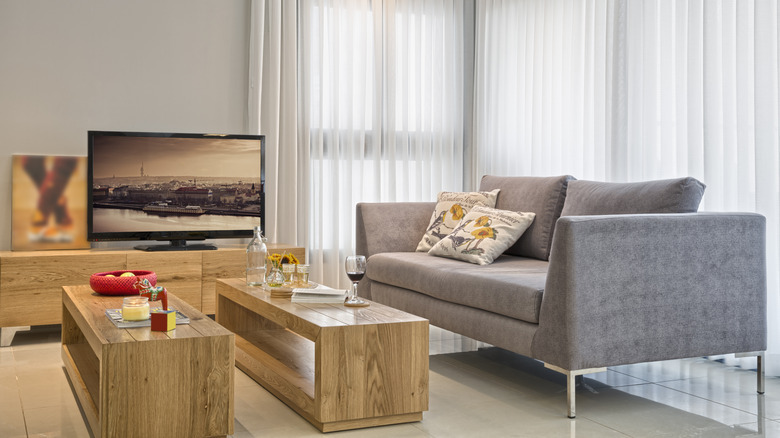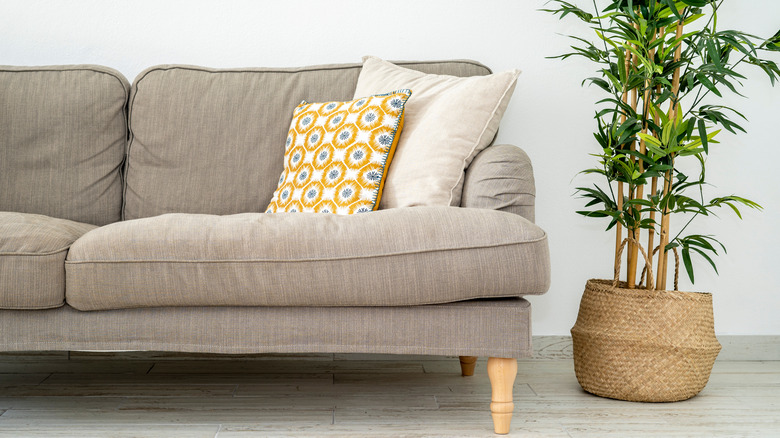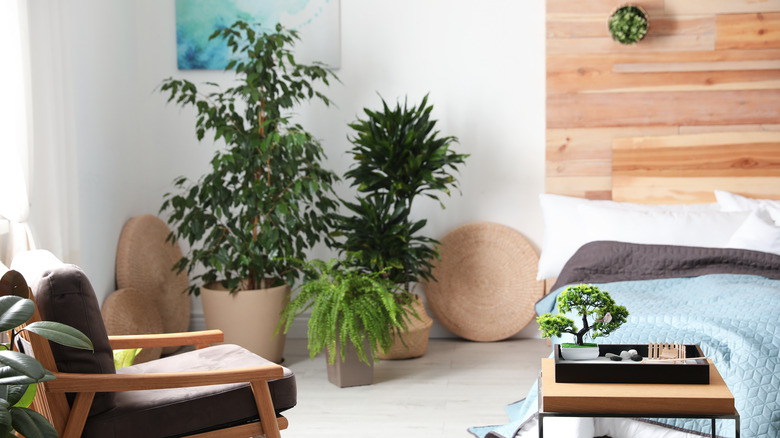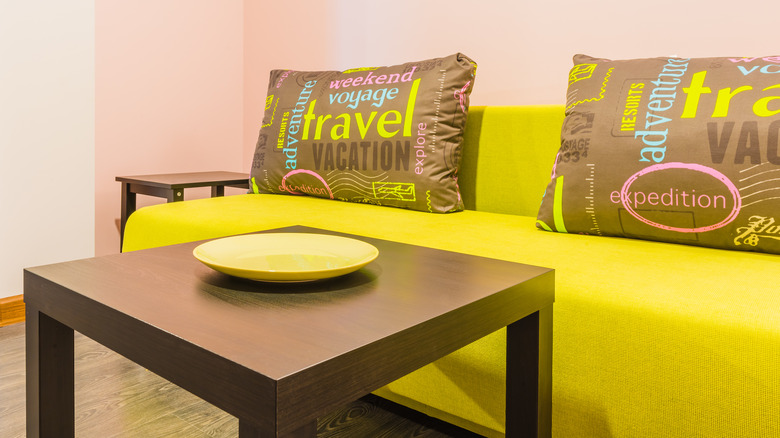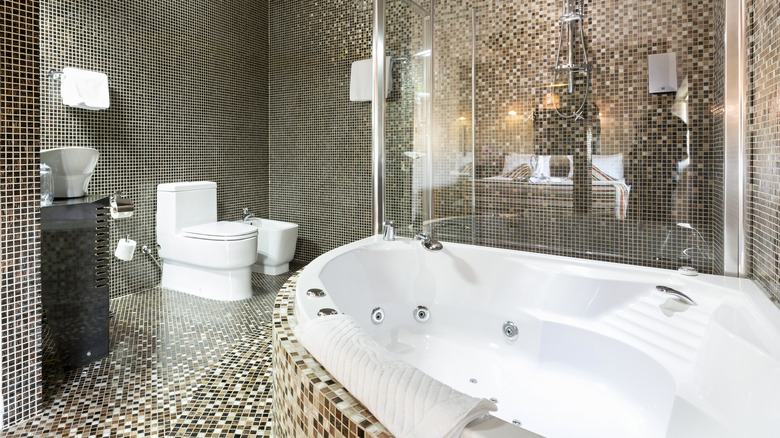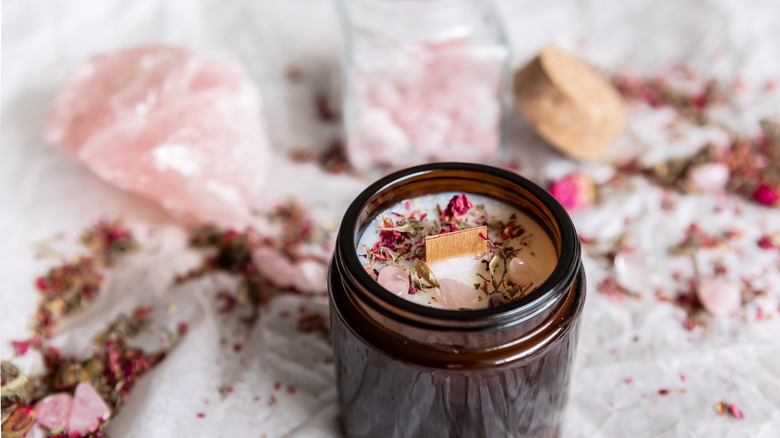What Is Feng Shui And How Do You Implement It In Your Home?
Feng shui. What is it? These words may come to mind: balance, design, or prosperity. It's a broad spectrum that encompasses a diverse number of elements, specifically tailored for the well-being of your life and home. An ancient art of arrangement, the philosophies of feng shui, or geomancy, were established in China over 3,000 years ago. Different mediums may include architecture, objects, and space with the purpose of achieving accord and the balance of energy within ourselves and the world around us. In Chinese, feng shui means "the way of wind (feng) and water (shui)," according to National Geographic. This term roots back further to the early Taoist belief of chi (or Qi), meaning "vital force." The Asian philosophy of yin and yang also plays a role in its development. The circulation of the black and white represents unity between yin (feminine/black) and yang (masculine/white), thus a symbol of stability within the process of feng shui (via The Spruce).
Prior to the magnetic compass, Chinese people originally used feng shui in determining the placement of grave sites for their dead. With time, its concepts have expanded from these eastern practices to the western world's correlation with nature and interior design. Whether through architectural design or the placement of furniture, feng shui uncovers the secrets to balancing chi, while providing the assurance of health and good fortune, per Crane & Canopy. The goal is to create positive change within your body and mind by utilizing the sanctuary that is your home.
Why should you participate in feng shui?
Presently, feng shui, including geomancy, is considered illegal in China (since the mid-20th century), mainly due to the superstition and deception behind its original practice, per the Independent. Why participate? Although the practice of feng shui has become somewhat controversial over the years, it doesn't fail to provide an individual or family some form of positive enrichment within their everyday lives. Whether it's used for balance or healing, your home reflects your life, and the aim should be to attain harmony via the interconnection between yourself and nature.
The action of arranging objects in your living space comes with repetition, as these kinds of changes can create adjustments towards healing. A physical shift in the room can offer aid in renewal just by rearranging furniture, or by removing potentially dangerous, sharp objects referred to as "poison arrows," per Thrive Global. Although we may admire the jagged edges of knives or swords as symbols of protection, research shows that humans relax efficiently when soft, rounded edges and shapes are present.
Even though feng shui stems from Taoism, the ancient Chinese art doesn't exactly have to be a religious activity. Experts at Healthline say that it can help people get in touch with their own vitality by means of their habitats. Creating a healthy depiction inside your home will translate to your outside life as well — especially if you live in a smaller, cramped space of an apartment.
Types of feng shui
There are numerous subcategories of feng shui, yet the main types are distinguished by traditional (or classical) and modern. All forms of feng shui implement the same fundamentals of yin and yang, and chi-energy, including the five elements. Within the traditional method are the schools of Form and Compass with Form being the oldest, original technique. Ancient people studied the land to decipher the best location for the growth of crops, including healthy terrain for their livestock and an abundance of life all around, according to Room Hints. Compass integrates the properties of space and time with the use of the bagua map. Instead of following the courses of north, south, east, and west, the house's front door is the guide to how your home harmonizes with each element (via Square One).
The meditative approach of Black Hat (BTB or Black Sect Tantric Buddhist) was established by Grandmaster Professor Lin Yun as early as the 1970s. By this introduction to the West, it has become the most used within the United States. Although this school of feng shui combines several philosophies like Buddhism, Taoism, and Confucianism, including Classical Feng Shui, the root of Black Hat stems from the act of meditation through mantras and chants. Modern, or New Age Feng Shui, is the most recent school, which developed in the 1990s. It employs the bagua but is enhanced with the use of crystals or figurines. It is seen as a generalized approach with many of the feng shui traditions lost from it.
How does feng shui work in the home?
How does feng shui work exactly? First, establish the aura that is your home. To achieve optimistic energy within a room, identify the command position. This is often a larger, significant piece of furniture with clandestine meanings like your bed (you), desk (career), or stove (wealth). Positioning these items in a spot that is visible through the door, yet not in direct alignment, will assist in your quest towards harmony and being in control of your life, suggests Architectural Digest. If your room struggles to attain this, you might add a mirror in reflection of the door to assist.
Another aspect to feng shui is to utilize the bagua map. Essentially, the bagua, or "eight areas," is a compass that designates the sections of your life in correspondence to the I-Ching trigram, per The Spruce. Within these eight sections, or "guas," is where these various life categories are integrated: wealth, reputation, love/marriage, family, children/creativity, knowledge, career, and travel/helpful people. Additionally, a ninth section is present in the center (health). Place the 3 X 3 grid overtop the main floor plan of your home (or room) with the front entrance located at the bottom; this typically appears as a trigram with octagonal sections. If the process becomes too complicated, you may want to hire a professional to assist you. Overall, this will give personal insight into the vibe of your life.
How to use feng shui in your home
Keeping the spaces in your home free of clutter is one of the most significant steps to initializing your home's chi. Make cleaning a daily routine by decluttering, dusting, organizing, and putting everything in its place. According to Thrive Global, this activity creates an optimum space for health and healing. Also, integrate vertical bookshelves or a potted plant where needed. This height will contribute a new sense of growth and development within your living space.
The front door is an essential item to attract successful feng shui. Keep the back door closed to contain your home's chi better, too. Try filling the entryway with plenty of natural light, including plant life and artwork to keep it clean and simple. Also, a door that opens inwardly presents an inviting vibe, while an outward one pushes chi-energy away, including off-putting visitors (via Feng Shui-Tips). If the front door opens outward, this may disrupt the flow of the house in its entirety.
You might also experiment with mirrors, which offer clear, reflective images provided naturally from the outside, such as flowers, trees, and water. Intentionally placed mirrors project introspection and revitalization into the space of your home. According to The Spruce, mirrors should be situated adjacent to the front door or a window. The process and practice of feng shui may also create a place of sanctuary, especially for your bedroom. Besides your partner, keep pictures of family outside the room, including your workspace.
How to apply the five elements
The process of applying feng shui to your home can be as dense as you want to make it, but the core should be simplistic. Besides the bagua map, another vital concept of feng shui consists of these five natural elements: earth, fire, metal, water, and wood. Each element evokes a tone that is valuable for your everyday life (via HGTV). The objective is to include these components for balance and comfort to flourish throughout your entire home. For example, a quiet corner might include a candle, small plant, river stones, and a wooden sculpture.
To determine what atmosphere of each room in your house will emanate, refer to the cardinal and ordinal directions for each element using the bagua map. Earth signifies health, awareness, and strength, and is also powerfully linked with relationships (familial and romantic). Use natural materials and objects to easily incorporate these qualities, per Extra Space Storage. With fire, you can express warmth and confidence with candles, electronics, or an indoor/outdoor fireplace or fire pit. Implementing metal provides mental clarity, along with focus and organization. Items that classify under this element include rocks/stones and materials and objects made of various metals like aluminum, gold, and silver. Adding the element of water arouses motivation and insightfulness. Again, reflective pieces can be incorporated as well as asymmetrical shapes, aquariums, and fountains. Wood can be expressed through plants, trees, furniture, and natural fabrics like cotton. Achieve multiple elements in one by using a potted plant.
Colors and décor of feng shui
Color connects us with our spiritual selves, whether it's a memory or a dream. Implementing colors within the home evokes enrichment and peace among other dispositions. You can color balance your home by adding tints and shades that are directly connected to the five elements. Focus on no more than three areas at time, per The Spruce. Refer to the nine life areas of the bagua energy map as your guide, as there you can match a color with your related room.
Blue (Gen) is associated with water, which assists in inspiration, knowledge, and a calm, meditative mind. Green (Zhen) compliments wood and growth within family and new projects. Red (Li) matches the element of fire, which ignites our life, including passion and reputation. Like sparkling amethyst rock, purple (Xun) exemplifies self-worth and wealth. Pink (Kun) invites new partnerships and healing. Yellow and brown (Tai Qi) represent earth, as they uplift our state of happiness, including a sense of encouragement and focus. White (Dui), including metallic features, encourages joy, the intention of children, and finishing projects. Black (Kan) focuses on your pathway, including career and social life. Gray (Qian) supports the concept of discovery and travel, including new people, places, and ideas. Colors can be applied on your walls or with decorative accents like pillows, a vase, or any other objects. No matter how you choose to represent these colors, they will support the dynamic force of the elements (via The Feng Shui Studio).
How to arrange your furniture
The flow of chi is crucial in the interest of arranging furniture feng shui style. When entering the living room, the pathway from the door should be distinctive and free of obstacles. Leave space between your furniture and the wall. Also, keep the room downsized by choosing a few essential pieces: a sofa, chair, or table. The coffee table is a central piece, a focal point as well as a tool to nurture conversations and social activities, per Extra Space Storage. Round or oval-shaped tables that are made of wood or metal are preferable. Additionally, the kitchen should be an open concept space with an uncluttered way to and from the sitting area. Like the living room furniture, keep the stove separate from the wall and make use of gaps or barriers to distinguish each of the kitchen's zones. In the bedroom, position all your furniture against the wall. The bed should not be placed in the direction of the door. Also, include pieces that have smooth edges; sharp ones are more threatening.
Once you have things strategically placed, make sure to provide lots of natural light; this goes especially for your living room and kitchen. Bright and open windows will assist in radiating positive energy throughout the heart of your living space (via Out & Out). Once again, refer to the bagua grid to find all the elements that you can acquire with your décor and furniture placement, ensuring feng shui quality.
Pros and cons of feng shui design
From colors to elements to style, feng shui may prove a disadvantage of being slightly overwhelming as well as costly. Take into consideration a budget for how much you plan to spend on new household décor, paint, or furniture. Based on your time as well, hiring a feng shui consultant might be necessary. Whether they charge by the hour, the room, or square footage, prices will likely vary depending upon their experience and the size of your home, per Home Advisor. Keep in mind that a consultation might typically range from approximately $100 to $400 per hour (or more). Redesigning your home is an investment and hiring an advisor may help relieve some of the stress.
Balance can also be a challenge, as there are some cons that may lead to bad feng shui in your home. If you have too much of an element, or one color, it may come off as too aggressive (to fiery) or possibly symbolize your weaknesses more than your strengths. Keep it simple! For example, remembering to put the toilet seat down can have a major impact on your home's feng shui. Because the drain's main function is to draw in matter and suck it down, so can it with the chi energy. This goes for tubs, sinks, and showers as well. Get in the habit of putting the seat down, including stopping these other drains daily.
Safety and protection
By simplifying your house or apartment, you've already taken a positive step towards newfound fortune and protection. It's vital to keep things tidy and out of the way, as obstructive items will cause more accidents and problems. Also, make sure you are in control of your comfort zone with the Command Position. Again, this is the most important piece of furniture to establish in each room. You should feel comfortable and secure in your own home by placing this in its prime spot. Additionally, crystals can also promote spiritual awareness. Through the stillness and grace of gemstones and rocks comes the energy to transform or uplift your mood or conditions. Using bagua, place them accordingly to their room and color. For example, purple/wealth might be amethyst, and pink/relationships could be rose quartz. Other crystals might include ammonite, citrine, clear quartz, and jade, per The Spruce.
Remember that the front door is the initial source of your home's energy, where the chi makes an entrance. Make sure you have a solid front door that cannot be deterred by undesirable energy or visitors. Another potential hazard to be aware of that disagrees with the flow of feng shui is a spiral staircase, an obvious threat to exclude, especially for children and the elderly. Besides crystals, a way to protect your home and self is to hang bells on the front door. This will easily alert you of anyone's comings and goings.
